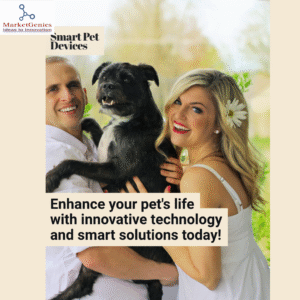Integration of Technology has an incredible yet positive impact on human life, In today’s tech-driven world, it’s no surprise that pet care is getting a digital upgrade. As more people welcome pets into their lives—and treat them like true family members—there’s been a noticeable shift toward smart pet gadgets Regardless it’s GPS collars that helps to track a runaway pup or an AI-powered feeders that make sure your cat never misses a meal, these devices are rapidly becoming more than just nice-to-haves.
No wonder knowing what started as a bit of a novelty is now turning into a real necessity. Pet parents want real-time updates, health insights, and smarter ways to manage daily routines. But while the excitement is real, so are the hurdles- high costs, tech learning curves, and concerns about privacy are all part of the story. The market is growing fast, but full adoption still comes with a few bumps along the way. Let’s study this industry through MarketGenics.

As per to a recent market study by MarketGenics, it is found that the global pet tech market was valued nearly at USD 7.63 billion in 2024 and is projected to grow to around USD 17.25 billion by 2030, at a compound annual growth rate (CAGR) of 14.56%. Reflective growth, a shift in consumer behavior, with pet owners seeking smart solutions that blend technology with daily pet care responsibilities.
Major factors favoring this market growth:
Growing awareness of pet health and wellness, leading to greater demand for personalized care
Even though smart pet devices are gaining traction, there are still a few roadblocks standing in the way of wider adoption:
Let’s face it—these devices aren’t cheap. GPS collars with all the bells and whistles or AI-powered feeders can feel like a luxury, especially for pet parents in emerging markets. A lot of people still see them as “nice to have,” not something that’s necessary.
For instance:
For many pet owners, the price tag just doesn’t yet justify the value.
These gadgets rely on Wi-Fi, Bluetooth, or mobile data to work smoothly. But in areas where internet connectivity is patchy or unreliable—think rural zones or smaller towns—that’s a big limitation. Plus, not everyone is super tech-savvy. Getting your smart pet camera to talk to Alexa or Google Home isn’t always as simple as it sounds.
That learning curve? It can be a turn-off, especially for older pet owners who just want something easy and straightforward.
Here’s a less-talked-about but very real concern—data privacy. Smart pet gadgets collect a surprising amount of personal info, like your pet’s health trends or even your daily home routines. And when that data’s floating around in the cloud, it opens the door to risks like hacking or unauthorized access.
A 2024 study by the European Pet Technology Alliance found that nearly 6 out of 10 users were worried about potential misuse of their data or device security. That’s a big red flag and a signal to companies that they need to do more—whether it’s offering better encryption, clearer privacy settings, or just educating users on how their data is being used.
To address the above challenges, manufacturers are:
One of the primary and most adopted segments of developed pet devices is GPS-enabled collars. Allowing owners to track their pet’s movement and location using real-time mapping and geofencing. This is particularly useful for dogs who are frequently outdoors or tend to wander.
Far off location tracking, smart collars today can also:
The smart-connected pet collar market alone current market size was around USD 423 million in 2024 and is expected to reach USD 1.03 billion by 2032, growing at a CAGR of 10.8%.
2. Automated Feeding Systems and AI Integration
AI-driven smart feeders are redefining how pet owners manage meal times. These devices:
Some AI feeders go a step further by integrating with wearable pet tech to provide dynamic feeding adjustments depending on the pet’s activity level, weight, or medical condition. These innovations are particularly helpful for pets requiring strict dietary management due to obesity, diabetes, or allergies.
3. Increased Humanization of Pets
The emotional bond between pets and their owners has evolved. Pets are increasingly treated as family members, which translates into higher spending on pet wellness, comfort, and lifestyle products. This trend is a strong driver for premium smart products like:
Surveys show that 74% of pet owners in North America are willing to invest in smart technologies to improve their pets’ lives, signaling growing consumer readiness for innovative solutions.
These developments highlight a move toward comprehensive smart pet ecosystems, rather than standalone products.
Looking ahead, the industry is set to expand beyond household pets. Applications are emerging in:
Meanwhile, increased affordability, better connectivity, and user-friendly interfaces are expected to lower the entry barrier, bringing smart pet care to a wider audience.
The rise of smart pet devices represents a convergence of technology, empathy, and convenience. As more households embrace pets as family members, the demand for innovative solutions to improve their care will continue to grow. While challenges remain—particularly regarding affordability and infrastructure—the future of pet tech is undeniably smart, connected, and transformative.
By providing comprehensive market intelligence, consumer insights, and growth forecasts, MarketGenics can guide businesses in the smart pet tech market toward innovation, better customer satisfaction, and sustainable growth.


MarketGenics India is a MRSI certified company.
Send us your resume at
info@marketgenics.co
© 2025 MarketGenics India Pvt Ltd.; All rights reserved